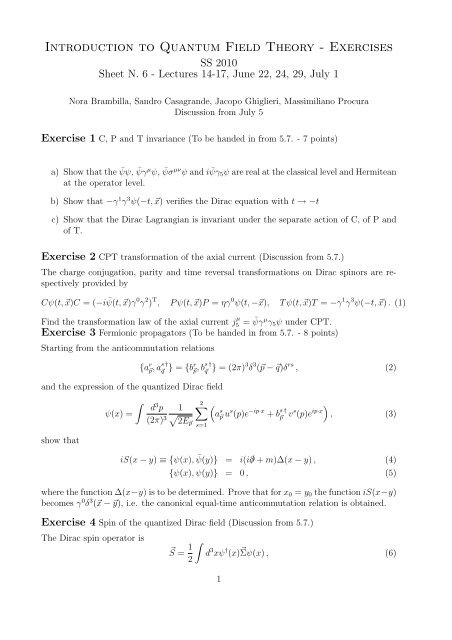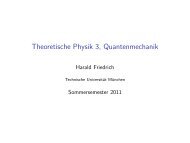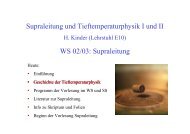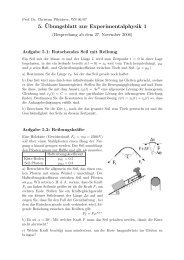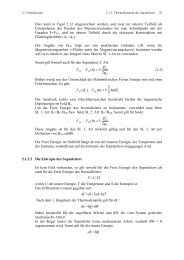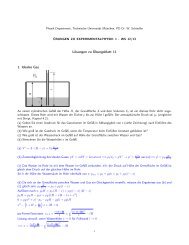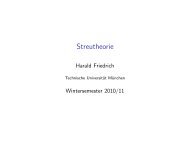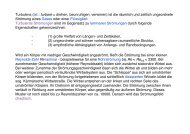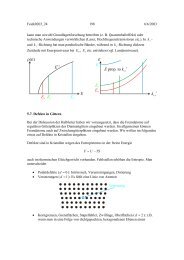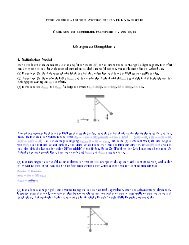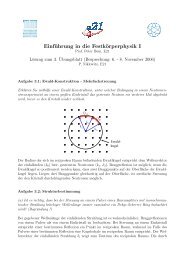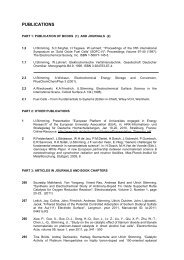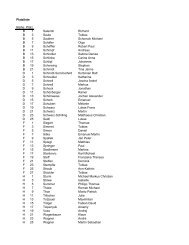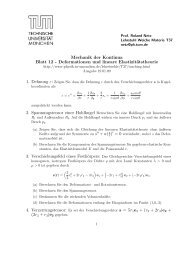Exercise sheet 6 - Lectures 14-17 - TUM
Exercise sheet 6 - Lectures 14-17 - TUM
Exercise sheet 6 - Lectures 14-17 - TUM
You also want an ePaper? Increase the reach of your titles
YUMPU automatically turns print PDFs into web optimized ePapers that Google loves.
Introduction to Quantum Field Theory - <strong>Exercise</strong>s<br />
SS 2010<br />
Sheet N. 6 - <strong>Lectures</strong> <strong>14</strong>-<strong>17</strong>, June 22, 24, 29, July 1<br />
Nora Brambilla, Sandro Casagrande, Jacopo Ghiglieri, Massimiliano Procura<br />
Discussion from July 5<br />
<strong>Exercise</strong> 1 C, P and T invariance (To be handed in from 5.7. - 7 points)<br />
a) Show that the ¯ ψψ, ¯ ψγ µ ψ, ¯ ψσ µν ψ and i ¯ ψγ5ψ are real at the classical level and Hermitean<br />
at the operator level.<br />
b) Show that −γ 1 γ 3 ψ(−t, x) verifies the Dirac equation with t → −t<br />
c) Show that the Dirac Lagrangian is invariant under the separate action of C, of P and<br />
of T.<br />
<strong>Exercise</strong> 2 CPT transformation of the axial current (Discussion from 5.7.)<br />
The charge conjugation, parity and time reversal transformations on Dirac spinors are respectively<br />
provided by<br />
Cψ(t, x)C = (−i ¯ ψ(t, x)γ 0 γ 2 ) T , P ψ(t, x)P = ηγ 0 ψ(t, −x), T ψ(t, x)T = −γ 1 γ 3 ψ(−t, x) . (1)<br />
Find the transformation law of the axial current j µ<br />
5 = ¯ ψγ µ γ5ψ under CPT.<br />
<strong>Exercise</strong> 3 Fermionic propagators (To be handed in from 5.7. - 8 points)<br />
Starting from the anticommutation relations<br />
and the expression of the quantized Dirac field<br />
show that<br />
<br />
ψ(x) =<br />
{a r s †<br />
p, aq } = {br s †<br />
p, bq } = (2π)3δ 3 (p − q)δ rs , (2)<br />
d 3 p<br />
(2π) 3<br />
1<br />
2Ep<br />
2 <br />
s=1<br />
a s p u s (p)e −ip·x s †<br />
+ bp vs (p)e ip·x<br />
<br />
, (3)<br />
iS(x − y) ≡ {ψ(x), ¯ ψ(y)} = i(i/∂ + m)∆(x − y) , (4)<br />
{ψ(x), ψ(y)} = 0 , (5)<br />
where the function ∆(x−y) is to be determined. Prove that for x0 = y0 the function iS(x−y)<br />
becomes γ 0 δ 3 (x − y), i.e. the canonical equal-time anticommutation relation is obtained.<br />
<strong>Exercise</strong> 4 Spin of the quantized Dirac field (Discussion from 5.7.)<br />
The Dirac spin operator is<br />
S = 1<br />
<br />
2<br />
d 3 xψ † (x) Σψ(x) , (6)<br />
1
where Σi = 1<br />
2ɛijkS jk . By substituting the expression (3) in (6), prove that in the rest frame<br />
s †<br />
(p = 0) the state created by ap with s = 1 has Sz = +1/2, while the one with s = 2 has<br />
Sz = −1/2. Prove also that for the antiparticles the opposite happens: the state created by<br />
s †<br />
bp with s = 1 has Sz = −1/2 and viceversa.<br />
<strong>Exercise</strong> 5 Four-point function (Discussion from 5.7.)<br />
Calculate 〈0| ¯ ψ(x1)ψ(x2)ψ(x3) ¯ ψ(x4)|0〉 for free fields. The result should be expressed in terms<br />
of vacuum expectation values of two fields.<br />
<strong>Exercise</strong> 6 On the electromagnetic field (To be handed in from 5.7. - 15 points)<br />
• Calculate the commutator<br />
in the Lorentz gauge.<br />
iD µν (x − y) = [A µ (x), A ν (y)] , (7)<br />
• Calculate the following commutators between components of the electric and magnetic<br />
fields:<br />
[E i (x), E j (y)] , [B i (x), B j (y)] , [E i (x), B j (y)] . (8)<br />
(Hint: use the Lorentz gauge when you express E i and B i in terms of the field A µ .)<br />
Calculate these commutators also for equal times, x 0 = y 0 .<br />
• Calculate<br />
〈0|{E i (x), B j (y)}|0〉 , 〈0|{B i (x), B j (y)}|0〉 , 〈0|{E i (x), E j (y)}|0〉 . (9)<br />
(Hint: start with the Fourier decompositions of E and B in terms of creation and<br />
annihilation operators.)<br />
<strong>Exercise</strong> 7 Projectors (Discussion from 5.7.)<br />
Consider<br />
where ¯ k µ = (k 0 , − k). Calculate:<br />
if k 2 = 0.<br />
P µν = g µν − kµ¯ k ν + k ν¯ k µ<br />
k · ¯ k<br />
, P µν<br />
⊥ = kµ¯ k ν + k ν¯ k µ<br />
k · ¯ k<br />
P µν Pνσ , P µν<br />
⊥ P ⊥ νσ , P µν + P µν<br />
⊥ , gµνPµν , g µν P ⊥ µν , P µ ν P νσ<br />
⊥<br />
<strong>Exercise</strong> 8 Massive vector fields (Reading exercise - Discussion from 5.7.)<br />
Consider the Proca Lagrangian<br />
(10)<br />
(11)<br />
L = − 1<br />
4 FµνF µν + 1<br />
2 m2 AµA µ . (12)<br />
2
Verify that it is not gauge invariant and show that the equations of motion are<br />
(∂ 2 + m 2 )A µ = 0 and ∂µA µ = 0 . (13)<br />
Perform a canonical quantization and verify that the theory describes a spin 1 particle.<br />
<strong>Exercise</strong> 9 Thermal QFT (Reading exercise - Discussion from 5.7.)<br />
Let H be a second quantized Hamiltonian of a free, real scalar field and β a real parameter.<br />
a) Prove the identity<br />
e −βH a † (p) = a † (p)e −β(H+Ep) . (<strong>14</strong>)<br />
Hint: To this end either apply both sides to a state |p1, pn〉, or define a function<br />
f(β) given by the difference of the two sides. You have f(0) = 0, calculate [H, a(p) † ] =<br />
Epa(p) † and obtain that the derivative of f(β) is −Hf(β). The solution of this equation<br />
with the boundary condition f(0) = 0 is f(β) = 0. This is a very general method to<br />
show operator equalities.<br />
b) According to quantum mechanics the expectation value of any operator O in a mixed<br />
state described by a density matrix ρ is given by Tr(ρO) where ρ is normalized to<br />
Tr(ρ) = 1. In a thermal state with temperature T = 1/β the density matrix is given<br />
by ρ = e −βH / Tr(e −βH ) and therefore the thermal expectation values are defined as<br />
〈O〉β = Tr(Oe−βH )<br />
Tr(e −βH )<br />
, (15)<br />
where the trace is taken over all Fock states. Using the result from part a) show that<br />
Then in a finite volume V we have<br />
〈a † (q) a(q)〉β = (2π)3 δ 3 (p − q)<br />
e βEp − 1<br />
〈a † (p) a(p)〉β =<br />
. (16)<br />
V<br />
eβEp . (<strong>17</strong>)<br />
− 1<br />
This shows that a(p) † / √ V creates quanta obeying the Bose-Einstein distribution.<br />
c) Repeat the exercise for anticommuting operators and verify that one obtains Fermi<br />
statistics.<br />
<strong>Exercise</strong> 10 Bogoliubov transformation (Reading exercise - Discussion from 5.7.)<br />
Consider a gas of N electrons in a box of volume V .<br />
a) Show that in the ground state the electrons fill all states with momenta |p| < pF ,<br />
given by N/V = p 3 F /(3π2 ). The state with all levels filled up to pF is called the Fermi<br />
vacuum and we denote it with |0〉F to distinguish it from the Fock vacuum |0〉 where<br />
simply all states are empty. The Fermi vacuum is the vacuum state of the system with<br />
subject to the constraint of a fixed number of particles N, while the Fock vacuum is<br />
the vacuum state of the system with no constraint on the particle number.<br />
3
) Let a(p, s), a † (p, s) be the usual annihilation and creation operators of the the electron,<br />
so by definition a(p, s)|0〉 = 0 ∀p, s. Verify that it is not true that a(p, s)|0〉F = 0 ∀p, s.<br />
That means a † (p, s) is not the appropriate operator to describe excitations above |0〉F .<br />
c) Define<br />
A(p, s) = θ(|p| − pF )a(p, s) + θ(pF − |p|)a † (−p, −s) , (18)<br />
and A † (p, s) correspondingly. Verify that A(p, s)|0〉F = 0 ∀p, s, and that A(p, s) and<br />
A † (q, r) still satisfy canonical anticommutation relations. Give a physical interpretation<br />
of the action of A † (q, r) on |0〉F .<br />
Equation (18) is a particular case of a Bogoliubov transformation which can be defined for<br />
both bosonic and fermionic operators as<br />
A(p, s) = αp a(p, s) − βp a † (−p, −s) , (19)<br />
and A † (p, s) correspondingly with αp and βp complex coefficients.<br />
d) Show that the condition that A(p, s) and A † (p, s) satisfy the canonical commutation<br />
relations, requires that<br />
|αp| 2 ∓ |βp| 2 = 1 and αpβ−p ∓ α−pβp = 0 . (20)<br />
The minus sign applies to the case of bosons, whereas the plus applies for fermions.<br />
e) Consider the spin zero case. We have two different types of particles: a-particles<br />
obtained by applying a † (p) on |0〉a and the A-particles obtained by acting with A † (p)<br />
on |0〉A (the vacua are generalizations of |0〉 and |0〉F ). Setting V = 1 the respective<br />
particle number operators are a † (p)a(p) and A † (p)A(p). Let |np〉 be an eigenstate of<br />
the operator a † (p)a(p) with eigenvalue np. Show that<br />
Np ≡ 〈np|A † (p)A(p)|np〉 = np + 2|βp| 2<br />
<br />
np + 1<br />
<br />
. (21)<br />
2<br />
Thus in particular the vacuum of the a-particles has Np = |βp| 2 . This means that<br />
in terms of A-particles the vacuum of the a-particles is a multiparticle state. States<br />
created by A † are often called quasiparticle states.<br />
Bogoliubov transformations of this type are used in condensed matter physics, in the context<br />
of superfluidity or superconductivity, in cosmology, and in QCD.<br />
4


